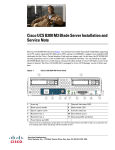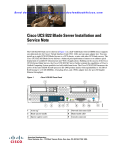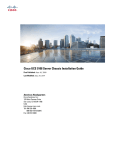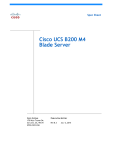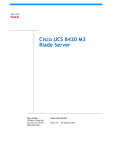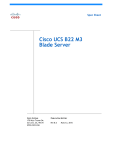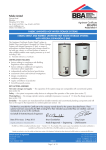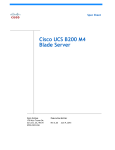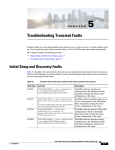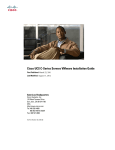Download Cisco Systems UCSSPENTVB200M3 Server User Manual
Transcript
Cisco UCS B200 M3 Blade Server Installation and Service Note Cisco UCS B200 M3 Blade Server 2 LEDs 2 Buttons 4 Connectors 4 Hard Drive Replacement 4 Blade Server Removal and Installation 6 Secure Digital (SD) Card Access 9 Removing a Blade Server Cover 9 Working Inside the Blade Server 13 Enabling a Trusted Platform Module 30 Server Troubleshooting 31 Server Configuration 31 Physical Specifications for the Cisco UCS B200 M3 31 Related Documentation 31 Obtaining Documentation and Submitting a Service Request 32 Revised: September 9, 2013, OL-26624-01 Cisco UCS B200 M3 Blade Server The Cisco UCS B200 M3 is an Intel-based, half-width blade supporting two CPU sockets using Intel E5-2600 series CPUs and up to 24 DIMMs; it supports one modular LOM (dedicated slot for Cisco's Virtual Interface Card) and one mezzanine adapter. At this time, the UCS B200 M2 (second generation) server is still available and is documented elsewhere. You can install up to eight UCS B200 Blade Servers to a UCS chassis, mixing with other models or Cisco UCS blade servers in the chassis if desired. Figure 1: Cisco UCS B200 M3 Front Panel 1 Asset tag 7 Network link status LED Each server has a blank plastic tag that pulls out of the front panel which is provided so that you can add your own asset tracking label without interfering with the intended air flow. 2 Blade ejector handle 8 Blade health LED 3 Ejector captive screw 9 Console connector 4 Hard drive bay 1 10 Reset button access 5 Hard drive bay 2 11 Beaconing LED and button 6 Power button and LED LEDs Server LEDs indicate whether the blade server is in active or standby mode, the status of the network link, the over all health of the blade server, and whether the server is set to give a flashing blue beaconing indication. The removable drives also have LEDs indicating hard disk access activity and disk health. 2 Table 1: Blade Server LEDs LED Color Description Power Off Power off. Green Normal operation. Amber Standby. Off None of the network links are up. Green At least one network link is up. Off Power off. Green Normal operation. Amber Minor error. Blinking Amber Critical error. Off Beaconing not enabled. Link Health Beaconing Blinking blue Beaconing to locate a selected blade—If the LED is not blinking, the 1 Hz blade is not selected. You can initiate beaconing in UCS Manager or with the button. Activity (Disk Drive) Health (Disk Drive) Off Inactive. Green Outstanding I/O to disk drive. Flashing Amber 4 Hz Rebuild in progress. Health LED will flash in unison. Flashing Amber 4 hz Identify drive active. Off Can mean either no fault detected or the drive is not installed. Flashing Amber 4 hz Identify drive active. If the Activity LED is also flashing amber, a drive rebuild is in progress. Amber Fault detected. 3 Buttons The Reset button is just inside the chassis and must be pressed using the tip of a paper clip or a similar item. Hold the button down for five seconds, and then release it to restart the server if other methods of restarting are not working. The beaconing function for an individual server may get turned on or off by pressing the combination button and LED. The power button and LED allows you to manually take a server temporarily out of service but leave it in a state where it can be restarted quickly. If the desired power state for a service profile associated with a blade server or an integrated rack-mount server is set to "off", using the power button or Cisco UCS Manager to reset the server will cause the desired power state of the server to become out of sync with the actual power state and the server may unexpected shutdown at a later time. To safely reboot a server from a power-down state, use the Boot Server action in Cisco UCS Manager. Connectors The console port allows a direct connection to a blade server to allow operating system installation and other management tasks to be done directly rather than remotely. The port uses the KVM dongle cable (N20-BKVM) which provides a connection into a Cisco UCS blade server; it has a DB9 serial connector, a VGA connector for a monitor, and dual USB ports for a keyboard and mouse. With this cable, you can create a direct connection to the operating system and the BIOS running on a blade server. A KVM cable ships standard with each blade chassis accessory kit. Figure 2: KVM Cable for Blade Servers 1 Connector to blade server slot 3 VGA connection for a monitor 2 DB9 serial connector 4 2-port USB connector for a mouse and keyboard Hard Drive Replacement Each blade has up to two front-accessible, hot-swappable, 2.5-inch drives. Unused hard drive bays should always be covered with cover plates (N20-BBLKD) to ensure proper cooling and ventilation. You can remove blade server hard drives without removing the blade server from the chassis. The drives supported in this blade server come with the drive sled attached. Spare drive sleds are not available. A list of currently supported drives is in the specification sheets at: http://www.cisco.com/en/US/products/ps10280/products_data_sheets_list.html 4 Before upgrading or adding an HDD to a running system, check the service profile in Cisco UCS Manager and make sure the new hardware configuration will be within the parameters allowed by the service profile. To prevent ESD damage, wear grounding wrist straps during these procedures and handle modules by the carrier edges only. Caution RAID Considerations Each blade contains an LSI SAS 2004 RAID controller embedded in the motherboard that is not separately replaceable. The controller supports RAID 0 and 1. If the drive being replaced was part of a RAID array, Cisco recommends using a new drive of identical size, model, and manufacturer to replace the failed drive. This recommendation comes from the industry standard practice of using drives of the same capacity when creating RAID volumes. If drives of different capacities are used, the useable portion of the smallest drive will be used on all drives that make up the RAID volume. If you ever need to move a RAID cluster from one server to another, both the old and new servers for the cluster must use the same LSI controller. For example, migration from a server with an LSI 1064E controller to a server with an LSI MegaRAID controller is not supported. Similarly, migrating a RAID cluster from a B200 M3 to a B420 M3 is not supported. For hard disk and RAID troubleshooting information, see the Cisco UCS Manager B-Series Troubleshooting Guide. Removing a Blade Server Hard Drive To remove a hard drive from a blade server, follow these steps: Procedure Step 1 Push the button to release the ejector, and then pull the hard drive from its slot. Figure 3: Removing the Hard Drive 5 Step 2 Step 3 Place the hard drive on an antistatic mat or antistatic foam if you are not immediately reinstalling it in another server. Install a hard disk drive blank faceplate (N20-BBLKD) to keep dust out of the blade server if the slot will remain empty. Installing a Blade Server Hard Drive Procedure Step 1 Place the hard drive lever into the open position by pushing the release button. Figure 4: Installing a Hard Drive in a Blade Server Step 2 Step 3 Gently slide the hard drive into the opening in the blade server until it seats into place. Push the hard drive lever into the closed position. You can use Cisco UCS Manager to format and configure RAID services. For details, see the Configuration Guide for the version of Cisco UCS Manager that you are using. The configuration guides are available at the following URL: http:// www.cisco.com/en/US/products/ps10281/products_installation_and_configuration_guides_list.html If you need to move a RAID cluster, see the Cisco UCS Manager B-Series Troubleshooting Guide. Blade Server Removal and Installation Before performing any internal operations on this blade server, you must remove it from the chassis. Caution 6 To prevent ESD damage, wear grounding wrist straps during these procedures and handle modules by the carrier edges only. Powering Off Blade Servers Using the Power Button Tip You can also shut the server down remotely using Cisco UCS Manager. For details, see the Configuration Guide for the version of Cisco UCS Manager that you are using. The configuration guides are available at the following URL: http://www.cisco.com/en/US/products/ps10281/products_installation_and_ configuration_guides_list.html Procedure Step 1 For each server in the chassis that you want to power off, check the color of the Power Status LED. • Green indicates that the server is running and must be shut down before it can be safely powered off. Go to Step 2. • Amber indicates that the server is already in standby mode and can be safely powered off. Go to Step 3. Step 2 Press and release the Power button, then wait until the Power Status LED changes to amber. The operating system performs a graceful shutdown and the server goes to standby mode. To avoid data loss or damage to your operating system, you should always invoke a graceful shutdown of the operating system. (Optional) If you are shutting down all blade servers in a chassis, disconnect the power cords from the chassis to completely power off the servers. Remove the appropriate servers from the chassis. Caution Step 3 Step 4 Removing a Blade Server Using UCS Manager, decommission the server before physically removing the server. To remove a blade server from the chassis, follow these steps: Procedure Step 1 Step 2 Step 3 Step 4 Step 5 Loosen the captive screw on the front of the blade. Remove the blade from the chassis by pulling the ejector lever on the blade until it unseats the blade server. Slide the blade part of the way out of the chassis, and place your other hand under the blade to support its weight. Once removed, place the blade on an antistatic mat or antistatic foam if you are not immediately reinstalling it into another slot. If the slot is to remain empty, install a blank faceplate (N20-CBLKB1) to keep dust out of the chassis. 7 Installing a Half-width Blade Server UCS B200 M3 and UCS B22 M3 half-width blade servers are interoperable in a UCS chassis with any other UCS blade servers, including prior generation B200 M2 and B200 M1 servers, or other UCS B-Series blade servers. To install a half-width blade server, follow these steps: Procedure Step 1 Grasp the front of the blade server and place your other hand under the blade to support it. Figure 5: Positioning a Blade Server in the Chassis 8 Step 2 Step 3 Step 4 Step 5 Step 6 Open the ejector lever in the front of the blade server. Gently slide the blade into the opening until you cannot push it any farther. Press the ejector lever so that it catches the edge of the chassis and presses the blade server all the way in. Tighten the captive screw on the front of the blade to no more than 3 in-lbs. Tightening with bare fingers only is unlikely to lead to stripped or damaged captive screws. Power on the server. UCS Manager automatically reacknowledges, reassociates, and recommissions the server, provided any hardware changes are allowed by the service profile. Secure Digital (SD) Card Access SD card slots are provided for future usage. Their use is not supported at product release. They will require a future software update to be used. Figure 6: SD Card Slot Locations Removing a Blade Server Cover Replacing the cover is the reverse of removing the cover. To open a blade server, follow these steps: 9 Procedure Step 1 Step 2 Press and hold the button down as shown in the figure below. While holding the back end of the cover, pull the cover back and then up. Figure 7: Opening a Cisco UCS B200 M3 Blade Server 10 Air Baffles The air baffles direct and improve air flow for the server components. Two identical baffles ship with each B200 M3 server. No tools are necessary to install them, just place them over the DIMMs as shown, with the holes in the center of the baffles aligned with the corresponding motherboard standoffs. Figure 8: Cisco UCS B200 M3 Air Baffles 11 Internal Components Figure 9: Inside View of the B200 M3 Blade Server 1 Hard drive bays 2 Internal USB connector Cisco UCS-USBFLSH-S-4GB= is recommended, but if another USB drive will be used it must be no wider than .8 inches, and no more than 1.345 inches long in order tp provide needed clearances to install or remove the USB drive. 3 Battery 4 CPU and heat sink 5 DIMM slots 6 Diagnostic button 7 Modular LOM (shown installed) 8 Adapter card connector (Adapter not shown installed) Diagnostics Button and LEDs At blade start-up, POST diagnostics test the CPUs, DIMMs, HDDs, and adapter cards, and any failure notifications are sent to UCS Manager. You can view these notifications in the System Error Log or in the output of the show tech-support command. If errors are found, an amber diagnostic LED also lights up next to the failed component. During run time, the blade BIOS, component drivers, and OS all monitor for hardware faults and will light up the amber diagnostic LED for a component if an uncorrectable error or correctable errors (such as a host ECC error) over the allowed threshold occur. LED states are saved, and if you remove the blade from the chassis the LED values will persist for up to 10 minutes. Pressing the LED diagnostics button on the motherboard causes the LEDs that currently show a component fault to light for up to 30 seconds for easier component identification. LED fault values are reset when the blade is reinserted into the chassis and booted, and the process begins from its start. If DIMM insertion errors are detected, they may cause the blade discovery to fail and errors will be reported in the server POST information, which is viewable using the UCS Manager GUI or CLI. UCS blade servers require specific rules to be followed when 12 populating DIMMs in a blade server, and the rules depend on the blade server model. Refer to the documentation for a specific blade server for those rules. HDD status LEDs are on the front face of the HDD. Faults on the CPU, DIMMs, or adapter cards also cause the server health LED to light solid amber for minor error conditions or blinking amber for critical error conditions. Working Inside the Blade Server Installing a Motherboard CMOS Battery All Cisco UCS blade servers use a CR2032 battery (Cisco PID N20-MBLIBATT=) to preserve BIOS settings while the server is powered down. There is danger of explosion if the battery is replaced incorrectly. Replace the battery only with the same or equivalent type recommended by the manufacturer. Dispose of used batteries according to the manufacturer’s instructions. Statement 1015 Warning To install or replace a motherboard complementary metal-oxide semiconductor (CMOS) battery, follow these steps: Procedure Step 1 Remove the old CMOS battery: a) Power off the blade, remove it from the chassis, and remove the top cover. b) Push the battery socket retaining clip away from the battery. c) Lift the battery from the socket. Use needle-nose pliers to grasp the battery if there is not enough clearance for your fingers. Step 2 Install a motherboard CMOS battery: a) Push the battery socket retaining clip away from where the battery fits in the housing. b) Insert the new battery into the socket with the battery’s positive (+) marking facing away from the retaining clip. Ensure that the retaining clip can click over the top of the battery to secure it in the housing. c) Replace the top cover. 13 d) Replace the server in the chassis and power on the blade by pressing the Power button. Figure 10: Location of the Motherboard CMOS Battery CPU and Heatsink Replacement Special Information For Upgrades to Intel E5-2600 v2 Series CPUs Caution You must upgrade your server firmware to the required minimum level before you upgrade to Intel E5-2600 v2 Series CPUs. Older firmware versions cannot recognize the new CPUs and this results in a non-bootable server. The minimum software and firmware versions required for the server to support Intel E5-2600 v2 Series CPUs are as follows: Table 2: Minimum Requirements For Intel E5-2600 v2 Series CPUs Software or Firmware 14 Minimum Version Server CIMC 2.1(3) Server BIOS 2.1(3) Cisco UCS Manager 2.1(3) Board controller firmware 8.0 Do one of the following actions: • If your server’s firmware and/or Cisco UCS Manager software are already at the required levels shown in the table above, you can replace the CPU hardware by using the procedures in this section. • If your server’s firmware and/or Cisco UCS Manager software is earlier than the required levels, use the instructions in the Cisco UCS B-Series Servers Upgrade Guide for Intel E5-2600 v2 Series CPUs to upgrade your firmware and software. After you upgrade, return to the procedures in this book to replace the CPU and heatsink hardware. Removing a CPU and Heat Sink You will use these procedures to move a CPU from one server to another, to replace a faulty CPU, or to upgrade from one CPU to another. Note The CPU pick and place tool is required to prevent damage to the connection pins between the motherboard and the CPU. Do not attempt this procedure without the required tool, which is included with each CPU option kit. Procedure Step 1 Unscrew the four captive screws securing the heat sink to the motherboard. See callout 1. Loosen one screw by a quarter turn, then move to the next in the X pattern shown in the following figure. Continue loosening until the heat sink can be lifted off. Step 2 Remove the heat sink (UCSB-HS-01-EP). See callout 2. Remove the existing thermal compound from the bottom of the heat sink using the cleaning kit (UCSX-HSCK= ) included with each CPU option kit. Follow the instructions on the two bottles of cleaning solvent. 15 Step 3 Unhook the first socket hook, which has the following icon: Step 4 Unhook the second socket hook, which has the following icon: Open the socket latch. See callout 5 in the following figure. Step 5 See callout 3 in the following figure. See callout 4 in the following figure. Figure 11: Removing the Heat Sink and Accessing the CPU Socket Step 6 Press the central button on the provided CPU pick and place tool (UCS-CPU-EP-PNP=) to release the catch. The CPU pick and place tool is included with each CPU option kit, or the tool may be purchased separately. Be sure to use the tool for the Intel Xeon E5-2600 Series processors. Step 7 Remove an old CPU as follows: a) Place the CPU pick and place tool on the CPU socket aligned with the arrow pointing to the CPU registration mark as shown in the following figure. b) Press the button/handle on the tool to grasp the installed CPU. 16 c) Lift the tool and CPU straight up. Figure 12: Proper Alignment of CPU Pick and Place Tool (for Intel Xeon E5-2600 Series Processors) 1 Alignment mark on the button/handle of the pick and place tool 2 Alignment mark on the socket Installing a New CPU and Heat Sink Before installing a new CPU in a server, verify the following: • The CPU is supported for that given server model. This may be verified via the server's Technical Specifications ordering guides or by the relevant release of the Cisco UCS Capability Catalog. • A BIOS update is available and installed that supports the CPU and the given server configuration. • If the server will be managed by Cisco UCS Manager, the service profile for this server in Cisco UCS Manager will recognize and allow the new CPU. Caution The Pick-and-Place tools used in this procedure are required to prevent damage to the contact pins between the motherboard and the CPU. Do not attempt this procedure without the required tools, which are included with each CPU option kit. If you do not have the tool, you can order a spare: Cisco PID UCS-CPU-EP-PNP= for 10-, 8-, 6-, 4-, or 2-core CPUs (green); UCS-CPU-EP2-PNP= for v2 12-core CPUs (purple). 17 Procedure Step 1 (Optional) If you are installing a CPU in a socket that had been shipped empty, there will be a protective cap intended to prevent bent or touched contact pins. The pick and pull cap tool provided can be used in a manner similar to a pair of tweezers. Grasp the protective cap and pivot as shown. Figure 13: Protective Cap Removal Step 2 Step 3 18 Release the catch on the pick and place tool by pressing the handle/button. Remove the new CPU from the packaging, and load it into the pick and place tool as follows: a) Confirm that the pedestal is set up correctly for your processor. The pedestal ships configured with the markings “LGA2011-R0” facing upward, and this is the correct orientation. b) Place the CPU on the pedestal. The CPU corners should fit snugly at the pedestal corners and the notches should meet the pegs perfectly. c) Place the CPU pick and place tool on the CPU pedestal aligned with the A1 arrow pointing to the A1 registration mark on the pedestal. d) Press the button/handle on the tool to grasp the CPU. e) Lift the tool and CPU straight up off of the pedestal. Figure 14: Loading the Pick and Place Tool 1 Alignment mark on the pick and place tool, CPU and pedestal 19 Step 4 Step 5 Place the CPU and tool on the CPU socket with the registration marks aligned as shown. Press the button/handle on the pick and place tool to release the CPU into the socket. Figure 15: Using the CPU Pick and Place Tool to Insert the CPU 1 20 Alignment mark on the tool button/handle 2 Alignment mark on the CPU socket Step 6 Step 7 Close the socket latch. See callout 1 in the following figure. Step 8 Secure the second hook, which has the following icon: Secure the first hook, which has the following icon: See callout 2 in the following figure. See callout 3 in the following figure. Figure 16: Replacing the Heat Sink (B200 M3 Shown) Step 9 Using the syringe of thermal grease provided with replacement CPUs and servers (UCS-CPU-GREASE=), add 2 cubic centimeters of thermal grease to the top of the CPU where it will contact the heat sink. Use the pattern shown. This should require half the contents of the syringe. Caution The thermal grease has very specific thermal properties, and thermal grease from other sources should not be substituted. Using other thermal grease may lead to damage. Note CPU spares come with two syringes of thermal grease; one with a blue cap and one with a red cap. The syringe with the blue cap is UCS-CPU-GREASE=, which is used with this server 21 Figure 17: Thermal Grease Application Pattern Step 10 Step 11 Replace the heat sink. See callout 4. Caution On certain models, heat sinks are keyed to fit into the plastic baffle extending from the motherboard. Do not force a heat sink if it is not fitting well, rotate it and re-orient the heat sink. Secure the heat sink to the motherboard by tightening the four captive screws a quarter turn at a time in an X pattern as shown in the upper right. Memory and Performance Installing Memory To install a DIMM into the blade server, follow these steps: 22 Procedure Step 1 Open both DIMM connector latches. Figure 18: Installing DIMMs in the Blade Server Step 2 Press the DIMM into its slot evenly on both ends until it clicks into place. DIMMs are keyed, if a gentle force is not sufficient, make sure the notch on the DIMM is correctly aligned. Be sure that the notch in the DIMM aligns with the slot. If the notch is misaligned you may damage the DIMM, the slot, or both. Press the DIMM connector latches inward slightly to seat them fully. Note Step 3 Supported DIMMs The DIMMs supported in this blade server are constantly being updated. A list of currently supported and available drives is in the specification sheets at: http://www.cisco.com/en/US/products/ps10280/products_data_sheets_list.html Cisco does not support third-party memory DIMMs, and in some cases their use may irreparably damage the server and require an RMA and down time. 23 Memory Arrangement The blade server contains 24 DIMM slots—12 for each CPU. Each set of 12 DIMM slots is arranged into four channels, where each channel has three DIMMs. Figure 19: Memory Slots within the Blade Server 1 Channels A-D for CPU 1 2 Channels E-H for CPU 2 DIMMs and Channels Each channel is identified by a letter—A, B, C, D for CPU1, and E, F, G, H for CPU 2. Each DIMM slot is numbered 0, 1, or 2. Note that each DIMM slot 0 is blue, each slot 1 is black, and each slot 2 is off-white or beige. 24 The figure below shows how DIMMs and channels are physically laid out on the blade server. The DIMM slots in the upper and lower right are associated with the second CPU (CPU shown on right in the diagram), while the DIMM slots in the upper and lower left are associated with the first CPU (CPU shown on left). Figure 20: Physical Representation of DIMMs and Channels 25 The figure below shows a logical view of the DIMMs and channels. Figure 21: Logical Representation of DIMMs and Channels DIMMs can be used in the blade server in a one DIMM per Channel (1DPC) configuration, in a two DIMMs per Channel (2DPC) configuration, or a three DIMMs per Channel (3DPC) configuration. Each CPU in a Cisco UCS B200 M3 blade server supports four channels of three memory slots each. In a 1 DPC configuration, DIMMs are in slot 0 only. In a 2 DPC configuration, DIMMs are in both slot 0 and slot 1. In a 3 DPC configuration, DIMMs are in slot 0, slot 1, and slot 2. 26 Table 3: Supported DIMM Population Order DIMMs per CPU CPU 1 installed slots CPU 2 installed slots 1 A0 E0 2 A0, B0 E0, F0 3 A0, B0, C0 E0, F0, G0 4 (Blue slots) A0, B0, C0, D0 E0, F0, G0, H0 5 A0, B0, C0, D0, A1 E0, F0, G0, H0, E1 6 A0, B0, C0, D0, A1, B1 E0, F0, G0, H0, E1, F1 7 A0, B0, C0, D0, A1, B1, C1 E0, F0, G0, H0, E1, F1, G1 8 (Blue and black slots) A0, B0, C0, D0, A1, B1, C1, D1 E0, F0, G0, H0, E1, F1, G1, H1 9 A0, B0, C0, D0, A1, B1, C1, D1,A2 E0, F0, G0, H0, E1, F1, G1, H1, E2 10 A0, B0, C0, D0, A1, B1, C1, D1,A2, B2 E0, F0, G0, H0, E1, F1, G1, H1, E2, F2 11 A0, B0, C0, D0, A1, B1, C1, D1,A2, B2, C2 E0, F0, G0, H0?E1, F1, G1, H1, E2, F2, G2 12 (Blue, black and beige slots) A0, B0, C0, D0?A1, B1, C1, D1,A2, B2, C2, D2 E0, F0, G0, H0, E1, F1, G1, H1, E2, F2, G2, H2 Memory Performance When considering the memory configuration of your blade server, there are several things you need to consider. For example: • When mixing DIMMs of different densities, the highest density DIMM goes in slot 0 then in descending density (ex: A0: UCS-MR-1X162RY-A , A1: UCS-MR-1X082RY-A, A2: UCS-MR-1X041RY-A) • Your selected CPU(s) can have some affect on performance. • DIMMs can be run in a 1DPC, a 2DPC, or a 3DPC configuration. 1 DPC and 2DPC can provide the maximum rated speed that the CPU and DIMMs are rated for. 3DPC causes the DIMMs to run at a slower speed. Memory Mirroring and RAS The Intel E5-2600 CPUs within the blade server support memory mirroring only when an even number of Channels are populated with DIMMs. If one or three channels are populated with DIMMs, memory mirroring is automatically disabled. Furthermore, if memory mirroring is used, DRAM size is reduced by 50 percent for reasons of reliability. 27 Installing a Modular LOM The Cisco VIC 1240 is a specialized modular Lan on Motherboard (mLOM) adapter that provides dual 2 x 10 Gb of Ethernet/ or Fiber Channel over Ethernet (FCoE) connectivity to each chassis. It plugs into the dedicated mLOM connector only. It is currently the only card that can be plugged into the mLOM connector and it will provide connectivity through either a 2100 series or 2200 series IOM. Note You must remove the adapter card to service the modular LOM. To install an mLOM on the blade server, follow these steps: Procedure Step 1 Position the mLOM’s board connector above the motherboard connector and align the captive screw to the standoff post on the motherboard. Step 2 Firmly press the modular LOM’s board connector into the motherboard connector. Tighten the captive screw. Tip To remove a modular LOM, reverse the above procedure. You might find it helpful when removing the connector from the motherboard to gently rock the board along the length of the connector until it loosens. Step 3 Figure 22: Installing an mLOM 28 Installing an Adapter Card The network adapters and interface cards all have a shared installation process and are constantly being updated. A list of currently supported and available models for this server is in the specification sheets at this URL: http://www.cisco.com/en/US/products/ps10280/products_data_sheets_list.html Note If a VIC 1240 mLOM is not installed, you must have an adapter card installed. Note Use of the adapters available for this server might require an upgrade to the FEX in the chassis. The 2104XP FEX is not compatible with any Cisco-certified adapter. If a VIC 1240 mLOM card is installed, you will have connectivity through the mLOM but other adapters will not be recognized. Use of all slots requires Cisco UCS 2200 series FEXes. If you are switching from one type of adapter card to another, before you physically perform the switch make sure that you download the latest device drivers and load them into the server’s operating system. For more information, see the firmware management chapter of one of the Cisco UCS Manager software configuration guides. The Cisco UCS 785GB or 365GB MLC Fusion-io Drive and LSI 400GB SLC WarpDrive have the same form factor as M3 adapter cards and can be installed and removed using the same procedures. Using these drives in a B200 M3 or B22 M3 blade server requires the presence of a VIC 1240 mLOM to provide blade I/O. They will not work in M1 and M2 generation Cisco UCS servers. These drives appear in Cisco UCS Manager as regular SSDs. Procedure Step 1 Step 2 Step 3 Position the adapter board connector above the motherboard connector and align the two adapter captive screws to the standoff posts (see callout 1) on the motherboard. Firmly press the adapter connector into the motherboard connector (see callout 2). Tighten the two captive screws (see callout 3). 29 Tip Removing an adapter card is the reverse of installing it. You might find it helpful when removing the connector from the motherboard to gently rock the board along the length of the connector until it loosens. Figure 23: Installing an Adapter Card Enabling a Trusted Platform Module The Trusted Platform Module (TPM, Cisco Product ID UCSX-TPM1-001) is a component that can securely store artifacts used to authenticate the server. These artifacts can include passwords, certificates, or encryption keys. A TPM can also be used to store platform measurements that help ensure that the platform remains trustworthy. Authentication (ensuring that the platform can prove that it is what it claims to be) and attestation (a process helping to prove that a platform is trustworthy and has not been breached) are necessary steps to ensure safer computing in all environments. A TPM is a factory-configurable option for this server. It is a requirement for the Intel Trusted Execution Technology (TXT) security feature, which must be enabled in the BIOS settings for a server equipped with a TPM. A TPM can not be added later by customers, or moved from one server to another. To enable the TPM: 30 Procedure Step 1 Step 3 Step 4 Enable Quiet Mode in the BIOS policy of the server’s Service Profile. Establish a direct connection to the server, either by connecting a keyboard, monitor, and mouse to the front panel using a KVM dongle (N20-BKVM) or by other means. Reboot the server. Press F2 during reboot to enter the BIOS setup screens. Step 5 On the Advanced tab, select Trusted Computing and press Enter. Step 6 Set the TPM Support option to Enable. Step 7 Press F10 to save and exit. Allow the server to finish booting. Step 2 Server Troubleshooting For general troubleshooting information, see the see the Cisco UCS Manager B-Series Troubleshooting Guide. Server Configuration Cisco UCS blade servers are intended to be configured and managed using Cisco UCS Manager. For details, see the Configuration Guide for the version of Cisco UCS Manager that you are using. The configuration guides are available at the following URL: http:/ /www.cisco.com/en/US/products/ps10281/products_installation_and_configuration_guides_list.html Physical Specifications for the Cisco UCS B200 M3 Specification Value Height 1.95 inches (50 mm) Width 8.00 inches (203 mm) Depth 24.4 inches (620 mm) Weight 15.0 lbs (6.8 kg) The system weight listed here is an estimate for a fully configured system and will vary depending on peripheral devices installed. Related Documentation The documentation set for the Cisco Unified Computing System environment is described in full at: 31 http://www.cisco.com/go/unifiedcomputing/b-series-doc For specifics on which component models are supported on which servers refer to the server's Technical Specifications ordering guide at: http://www.cisco.com/en/US/products/ps10493/products_data_sheets_list.html Obtaining Documentation and Submitting a Service Request For information on obtaining documentation, submitting a service request, and gathering additional information, see the monthly What's New in Cisco Product Documentation, which also lists all new and revised Cisco technical documentation. Subscribe to the What's New in Cisco Product Documentation as a Really Simple Syndication (RSS) feed and set content to be delivered directly to your desktop using a reader application. The RSS feeds are a free service and Cisco currently supports RSS version 2.0. Follow Cisco UCS Docs on Twitter to receive document update notifications. 32 THE SPECIFICATIONS AND INFORMATION REGARDING THE PRODUCTS IN THIS MANUAL ARE SUBJECT TO CHANGE WITHOUT NOTICE. ALL STATEMENTS, INFORMATION, AND RECOMMENDATIONS IN THIS MANUAL ARE BELIEVED TO BE ACCURATE BUT ARE PRESENTED WITHOUT WARRANTY OF ANY KIND, EXPRESS OR IMPLIED. USERS MUST TAKE FULL RESPONSIBILITY FOR THEIR APPLICATION OF ANY PRODUCTS. THE SOFTWARE LICENSE AND LIMITED WARRANTY FOR THE ACCOMPANYING PRODUCT ARE SET FORTH IN THE INFORMATION PACKET THAT SHIPPED WITH THE PRODUCT AND ARE INCORPORATED HEREIN BY THIS REFERENCE. IF YOU ARE UNABLE TO LOCATE THE SOFTWARE LICENSE OR LIMITED WARRANTY, CONTACT YOUR CISCO REPRESENTATIVE FOR A COPY. The following information is for FCC compliance of Class A devices: This equipment has been tested and found to comply with the limits for a Class A digital device, pursuant to part 15 of the FCC rules. These limits are designed to provide reasonable protection against harmful interference when the equipment is operated in a commercial environment. This equipment generates, uses, and can radiate radio-frequency energy and, if not installed and used in accordance with the instruction manual, may cause harmful interference to radio communications. Operation of this equipment in a residential area is likely to cause harmful interference, in which case users will be required to correct the interference at their own expense. The following information is for FCC compliance of Class B devices: This equipment has been tested and found to comply with the limits for a Class B digital device, pursuant to part 15 of the FCC rules. These limits are designed to provide reasonable protection against harmful interference in a residential installation. This equipment generates, uses and can radiate radio frequency energy and, if not installed and used in accordance with the instructions, may cause harmful interference to radio communications. However, there is no guarantee that interference will not occur in a particular installation. If the equipment causes interference to radio or television reception, which can be determined by turning the equipment off and on, users are encouraged to try to correct the interference by using one or more of the following measures: • Reorient or relocate the receiving antenna. • Increase the separation between the equipment and receiver. • Connect the equipment into an outlet on a circuit different from that to which the receiver is connected. • Consult the dealer or an experienced radio/TV technician for help. Modifications to this product not authorized by Cisco could void the FCC approval and negate your authority to operate the product The Cisco implementation of TCP header compression is an adaptation of a program developed by the University of California, Berkeley (UCB) as part of UCB’s public domain version of the UNIX operating system. All rights reserved. Copyright © 1981, Regents of the University of California. NOTWITHSTANDING ANY OTHER WARRANTY HEREIN, ALL DOCUMENT FILES AND SOFTWARE OF THESE SUPPLIERS ARE PROVIDED "AS IS" WITH ALL FAULTS. CISCO AND THE ABOVE-NAMED SUPPLIERS DISCLAIM ALL WARRANTIES, EXPRESSED OR IMPLIED, INCLUDING, WITHOUT LIMITATION, THOSE OF MERCHANTABILITY, FITNESS FOR A PARTICULAR PURPOSE AND NONINFRINGEMENT OR ARISING FROM A COURSE OF DEALING, USAGE, OR TRADE PRACTICE. IN NO EVENT SHALL CISCO OR ITS SUPPLIERS BE LIABLE FOR ANY INDIRECT, SPECIAL, CONSEQUENTIAL, OR INCIDENTAL DAMAGES, INCLUDING, WITHOUT LIMITATION, LOST PROFITS OR LOSS OR DAMAGE TO DATA ARISING OUT OF THE USE OR INABILITY TO USE THIS MANUAL, EVEN IF CISCO OR ITS SUPPLIERS HAVE BEEN ADVISED OF THE POSSIBILITY OF SUCH DAMAGES. Any Internet Protocol (IP) addresses and phone numbers used in this document are not intended to be actual addresses and phone numbers. Any examples, command display output, network topology diagrams, and other figures included in the document are shown for illustrative purposes only. Any use of actual IP addresses or phone numbers in illustrative content is unintentional and coincidental. Cisco and the Cisco logo are trademarks or registered trademarks of Cisco and/or its affiliates in the U.S. and other countries. To view a list of Cisco trademarks, go to this URL: http:// www.cisco.com/go/trademarks. Third-party trademarks mentioned are the property of their respective owners. The use of the word partner does not imply a partnership relationship between Cisco and any other company. (1110R) © 2012-2013 Cisco Systems, Inc. All rights reserved. Americas Headquarters Cisco Systems, Inc. San Jose, CA 95134-1706 USA Asia Pacific Headquarters Cisco Systems (USA) Pte. Ltd. Singapore Europe Headquarters Cisco Systems International BV Amsterdam, The Netherlands Cisco has more than 200 offices worldwide. Addresses, phone numbers, and fax numbers are listed on the Cisco Website at www.cisco.com/go/offices.


































